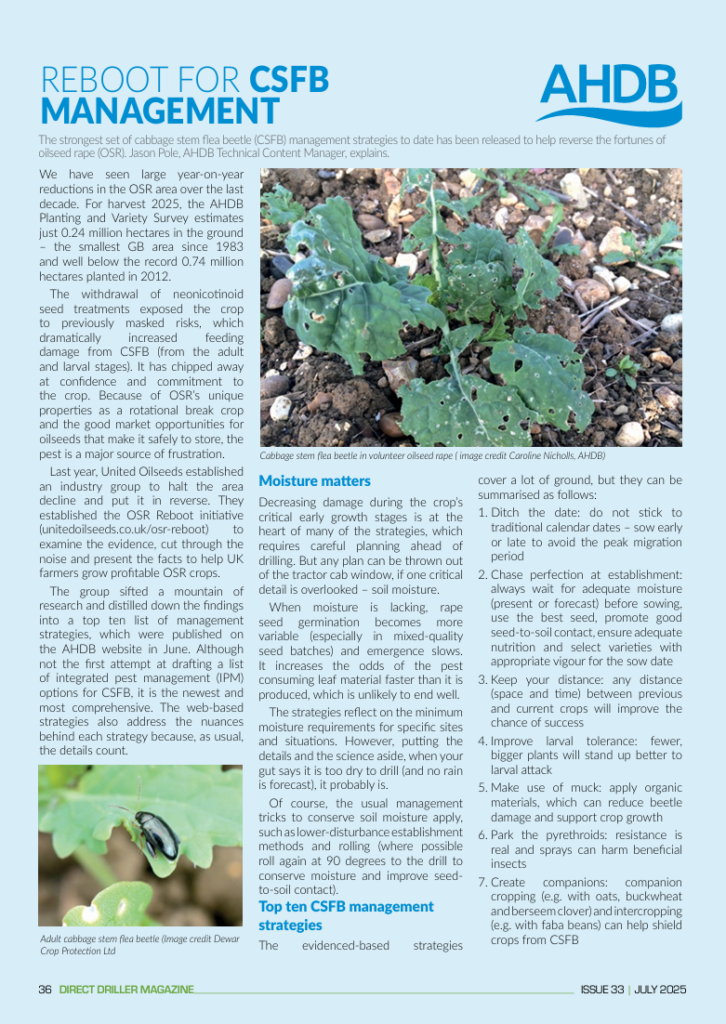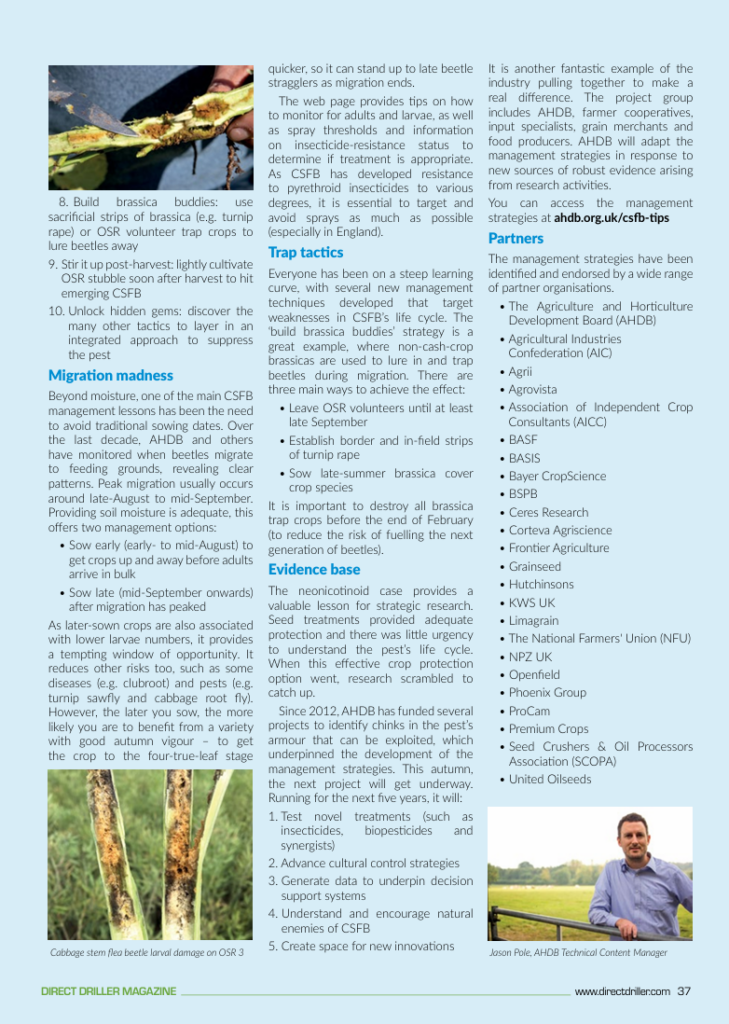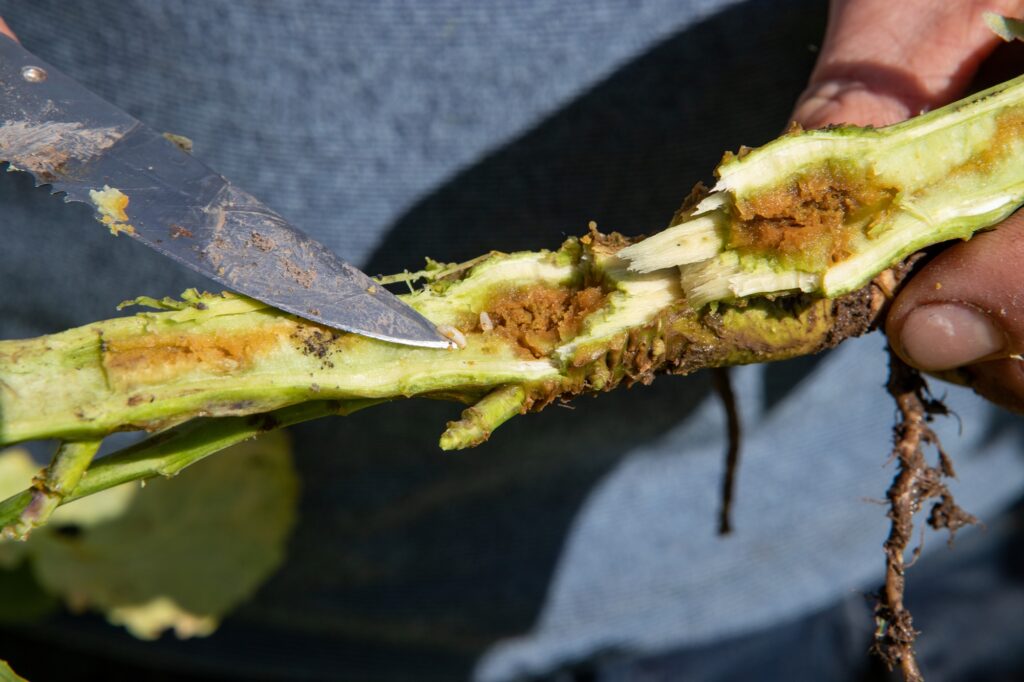The strongest set of cabbage stem flea beetle (CSFB) management strategies to date has been released to help reverse the fortunes of oilseed rape (OSR). Jason Pole, AHDB Technical Content Manager, explains.
We have seen large year-on-year reductions in the OSR area over the last decade. For harvest 2025, the AHDB Planting and Variety Survey estimates just 0.24 million hectares in the ground – the smallest GB area since 1983 and well below the record 0.74 million hectares planted in 2012.
The withdrawal of neonicotinoid seed treatments exposed the crop to previously masked risks, which dramatically increased feeding damage from CSFB (from the adult and larval stages). It has chipped away at confidence and commitment to the crop. Because of OSR’s unique properties as a rotational break crop and the good market opportunities for oilseeds that make it safely to store, the pest is a major source of frustration.
Last year, United Oilseeds established an industry group to halt the area decline and put it in reverse. They established the OSR Reboot initiative (unitedoilseeds.co.uk/osr-reboot) to examine the evidence, cut through the noise and present the facts to help UK farmers grow profitable OSR crops.
The group sifted a mountain of research and distilled down the findings into a top ten list of management strategies, which were published on the AHDB website in June. Although not the first attempt at drafting a list of integrated pest management (IPM) options for CSFB, it is the newest and most comprehensive. The web-based strategies also address the nuances behind each strategy because, as usual, the details count.
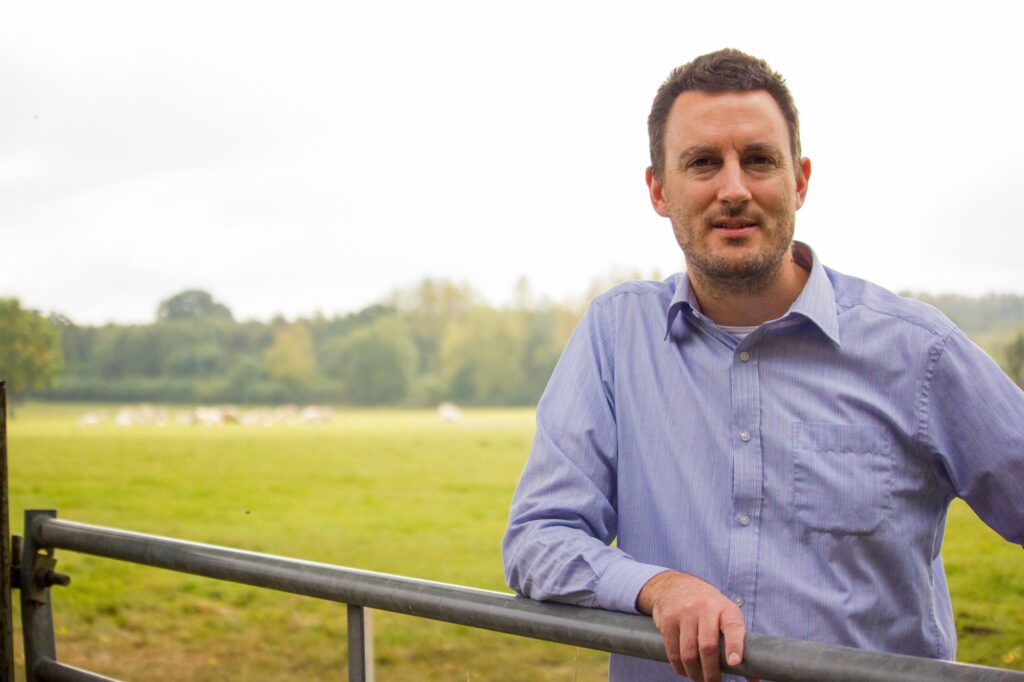
Moisture matters
Decreasing damage during the crop’s critical early growth stages is at the heart of many of the strategies, which requires careful planning ahead of drilling. But any plan can be thrown out of the tractor cab window, if one critical detail is overlooked – soil moisture.
When moisture is lacking, rape seed germination becomes more variable (especially in mixed-quality seed batches) and emergence slows. It increases the odds of the pest consuming leaf material faster than it is produced, which is unlikely to end well.
The strategies reflect on the minimum moisture requirements for specific sites and situations. However, putting the details and the science aside, when your gut says it is too dry to drill (and no rain is forecast), it probably is.
Of course, the usual management tricks to conserve soil moisture apply, such as lower-disturbance establishment methods and rolling (where possible roll again at 90 degrees to the drill to conserve moisture and improve seed-to-soil contact).
Top ten CSFB management strategies
The evidenced-based strategies cover a lot of ground, but they can be summarised as follows:
- Ditch the date: do not stick to traditional calendar dates – sow early or late to avoid the peak migration period
- Chase perfection at establishment: always wait for adequate moisture (present or forecast) before sowing, use the best seed, promote good seed-to-soil contact, ensure adequate nutrition and select varieties with appropriate vigour for the sow date
- Keep your distance: any distance (space and time) between previous and current crops will improve the chance of success
- Improve larval tolerance: fewer, bigger plants will stand up better to larval attack
- Make use of muck: apply organic materials, which can reduce beetle damage and support crop growth
- Park the pyrethroids: resistance is real and sprays can harm beneficial insects
- Create companions: companion cropping (e.g. with oats, buckwheat and berseem clover) and intercropping (e.g. with faba beans) can help shield crops from CSFB
- Build brassica buddies: use sacrificial strips of brassica (e.g. turnip rape) or OSR volunteer trap crops to lure beetles away
- Stir it up post-harvest: lightly cultivate OSR stubble soon after harvest to hit emerging CSFB
- Unlock hidden gems: discover the many other tactics to layer in an integrated approach to suppress the pest
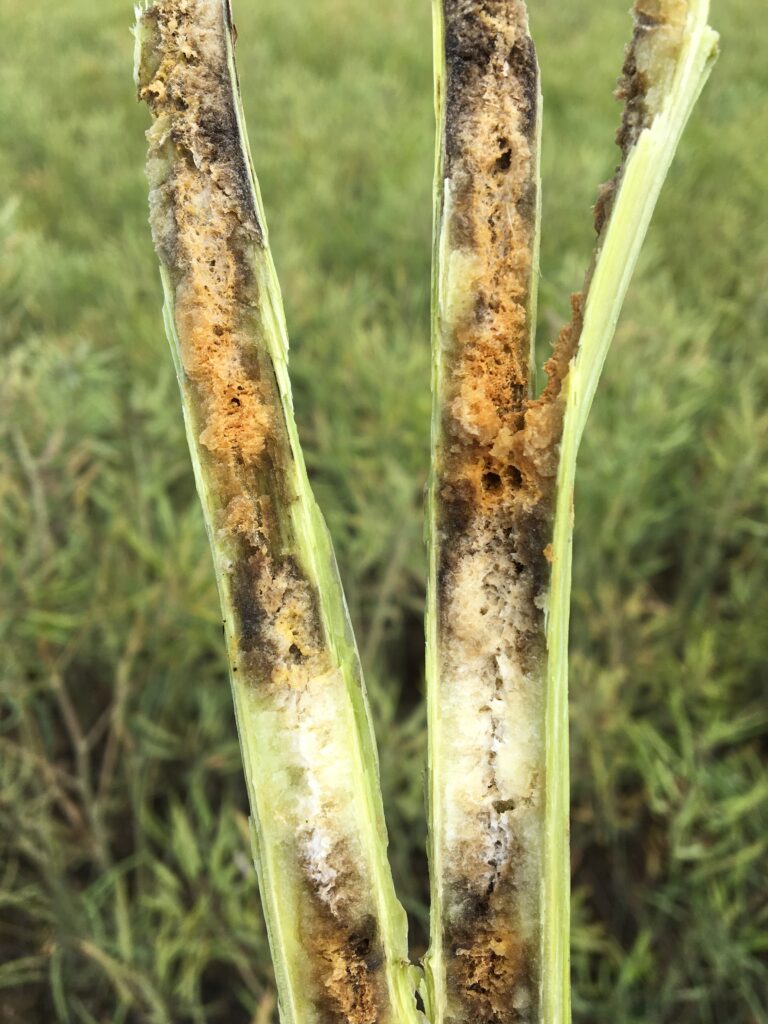
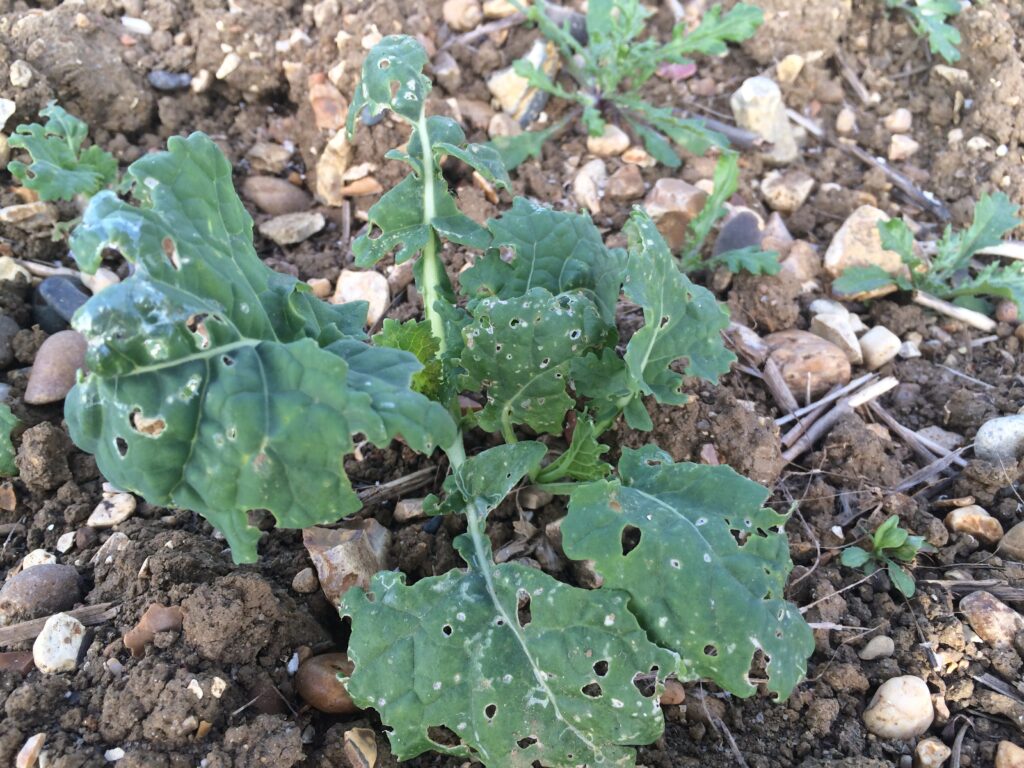
Migration madness
Beyond moisture, one of the main CSFB management lessons has been the need to avoid traditional sowing dates. Over the last decade, AHDB and others have monitored when beetles migrate to feeding grounds, revealing clear patterns. Peak migration usually occurs around late-August to mid-September. Providing soil moisture is adequate, this offers two management options:
- Sow early (early- to mid-August) to get crops up and away before adults arrive in bulk
- Sow late (mid-September onwards) after migration has peaked
As later-sown crops are also associated with lower larvae numbers, it provides a tempting window of opportunity. It reduces other risks too, such as some diseases (e.g. clubroot) and pests (e.g. turnip sawfly and cabbage root fly). However, the later you sow, the more likely you are to benefit from a variety with good autumn vigour – to get the crop to the four-true-leaf stage quicker, so it can stand up to late beetle stragglers as migration ends.
The web page provides tips on how to monitor for adults and larvae, as well as spray thresholds and information on insecticide-resistance status to determine if treatment is appropriate. As CSFB has developed resistance to pyrethroid insecticides to various degrees, it is essential to target and avoid sprays as much as possible (especially in England).

Trap tactics
Everyone has been on a steep learning curve, with several new management techniques developed that target weaknesses in CSFB’s life cycle. The ‘build brassica buddies’ strategy is a great example, where non-cash-crop brassicas are used to lure in and trap beetles during migration. There are three main ways to achieve the effect:
- Leave OSR volunteers until at least late September
- Establish border and in-field strips of turnip rape
- Sow late-summer brassica cover crop species
It is important to destroy all brassica trap crops before the end of February (to reduce the risk of fuelling the next generation of beetles).
Evidence base
The neonicotinoid case provides a valuable lesson for strategic research. Seed treatments provided adequate protection and there was little urgency to understand the pest’s life cycle. When this effective crop protection option went, research scrambled to catch up.
Since 2012, AHDB has funded several projects to identify chinks in the pest’s armour that can be exploited, which underpinned the development of the management strategies. This autumn, the next project will get underway. Running for the next five years, it will:
- Test novel treatments (such as insecticides, biopesticides and synergists)
- Advance cultural control strategies
- Generate data to underpin decision support systems
- Understand and encourage natural enemies of CSFB
- Create space for new innovations
It is another fantastic example of the industry pulling together to make a real difference. The project group includes AHDB, farmer cooperatives, input specialists, grain merchants and food producers. AHDB will adapt the management strategies in response to new sources of robust evidence arising from research activities.
You can access the management strategies at ahdb.org.uk/csfb-tips
Partners
The management strategies have been identified and endorsed by a wide range of partner organisations.
- The Agriculture and Horticulture Development Board (AHDB)
- Agricultural Industries Confederation (AIC)
- Agrii
- Agrovista
- Association of Independent Crop Consultants (AICC)
- BASF
- BASIS
- Bayer CropScience
- BSPB
- Ceres Research
- Corteva Agriscience
- Frontier Agriculture
- Grainseed
- Hutchinsons
- KWS UK
- Limagrain
- The National Farmers’ Union (NFU)
- NPZ UK
- Openfield
- Phoenix Group
- ProCam
- Premium Crops
- Seed Crushers & Oil Processors Association (SCOPA)
- United Oilseeds
